Impact of Intragranular Substructure Parameters on the Forming Limit Diagrams of Single-Phase B.C.C. Steels
Abstract
:1. Introduction
2. Elastic-Plastic Self-Consistent Modeling Taking Dislocation Patterning into Account
2.1. Single Crystal Plasticity Modeling
2.2. Intragranular Substructure Modeling
2.2.1. Description of Dislocation Networks inside Grains of Deformed B.C.C. Metals
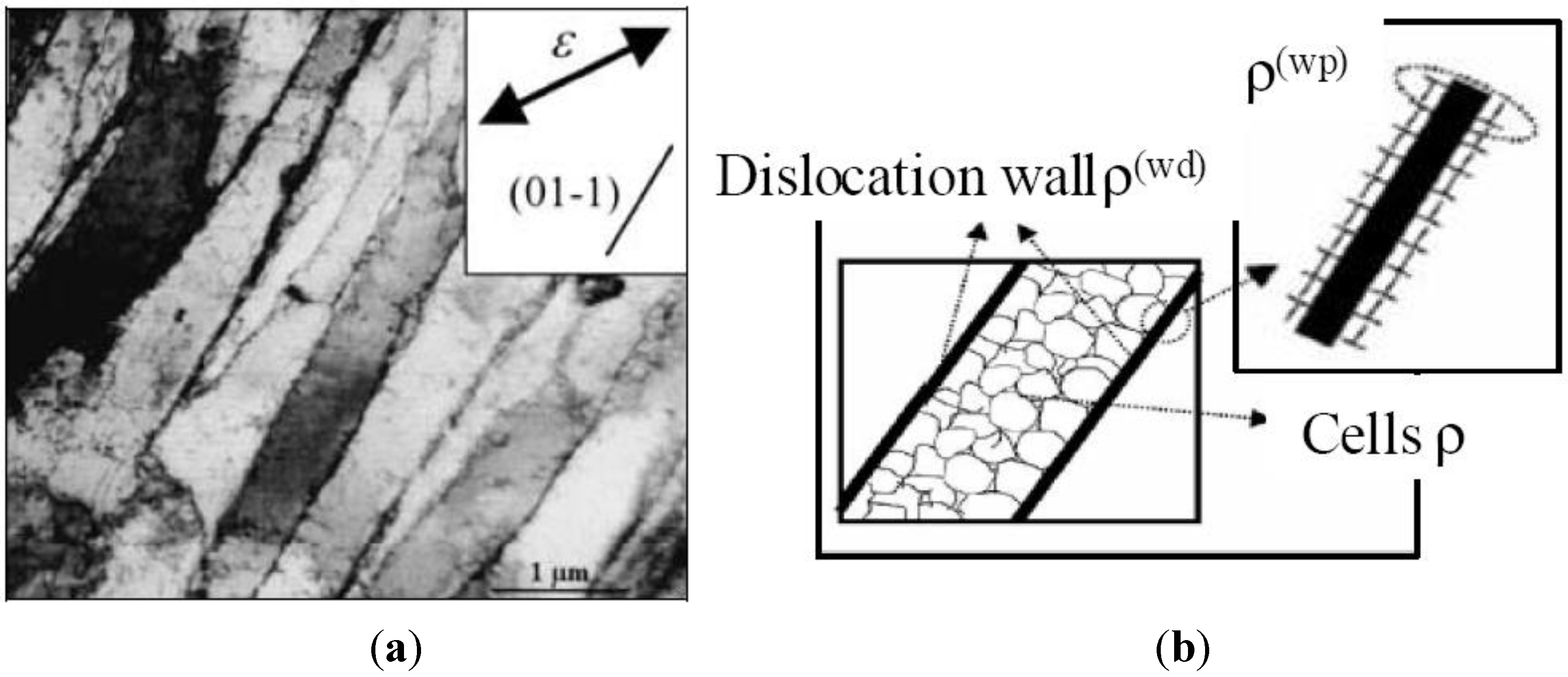
2.2.2. Intensity of Currently Existing Dense Dislocation Walls
2.2.3. Polarity Assigned to Currently Existing Dense Dislocation Walls
2.2.4. Randomly Stored Dislocations inside Cells
2.2.5. Previously Existing Dense Dislocation Walls
2.2.6. Critical Resolved Shear Stresses
2.3. Scale Transition Scheme—Macroscopic Stress/Strain Response of Single-Phase B.C.C. Steel
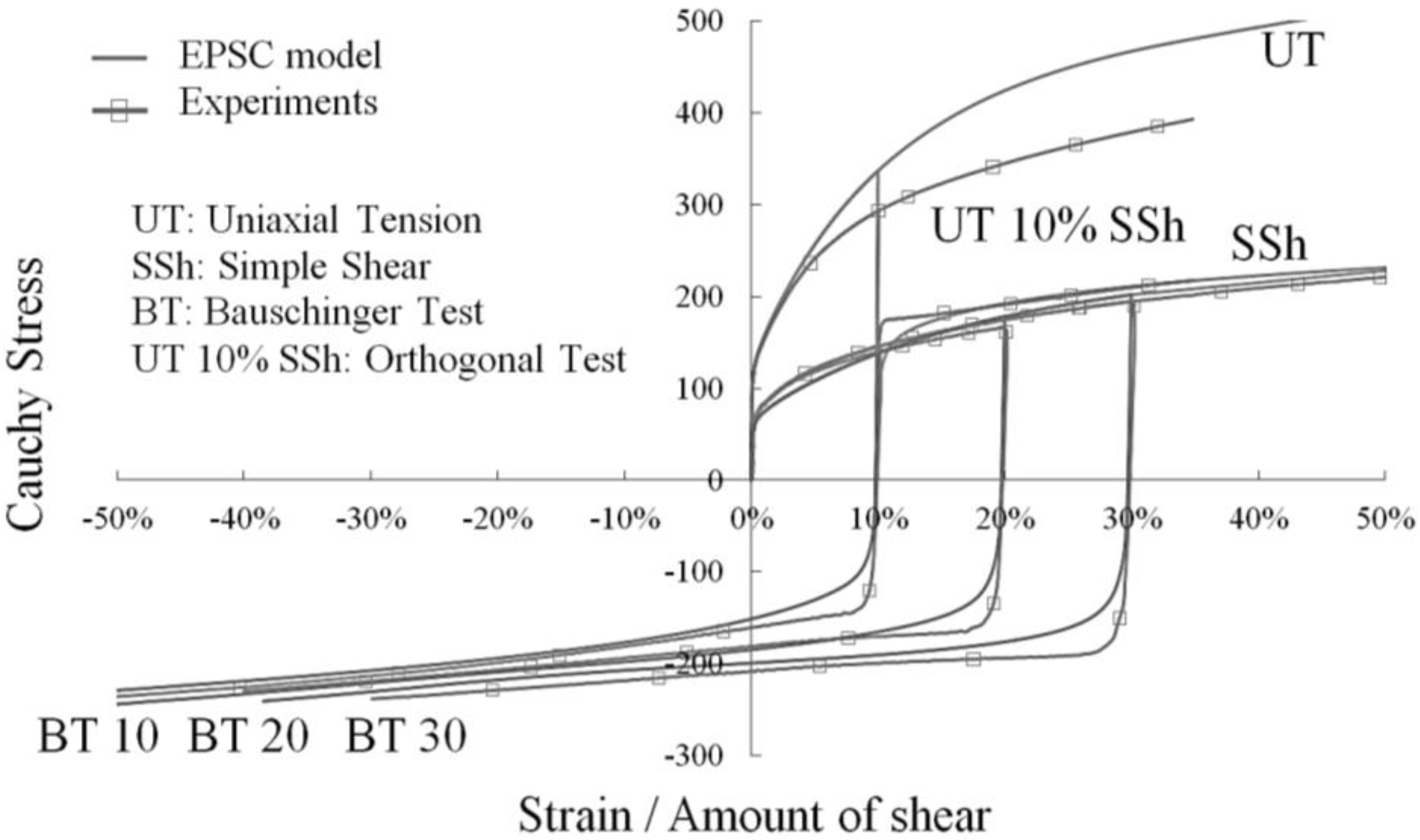
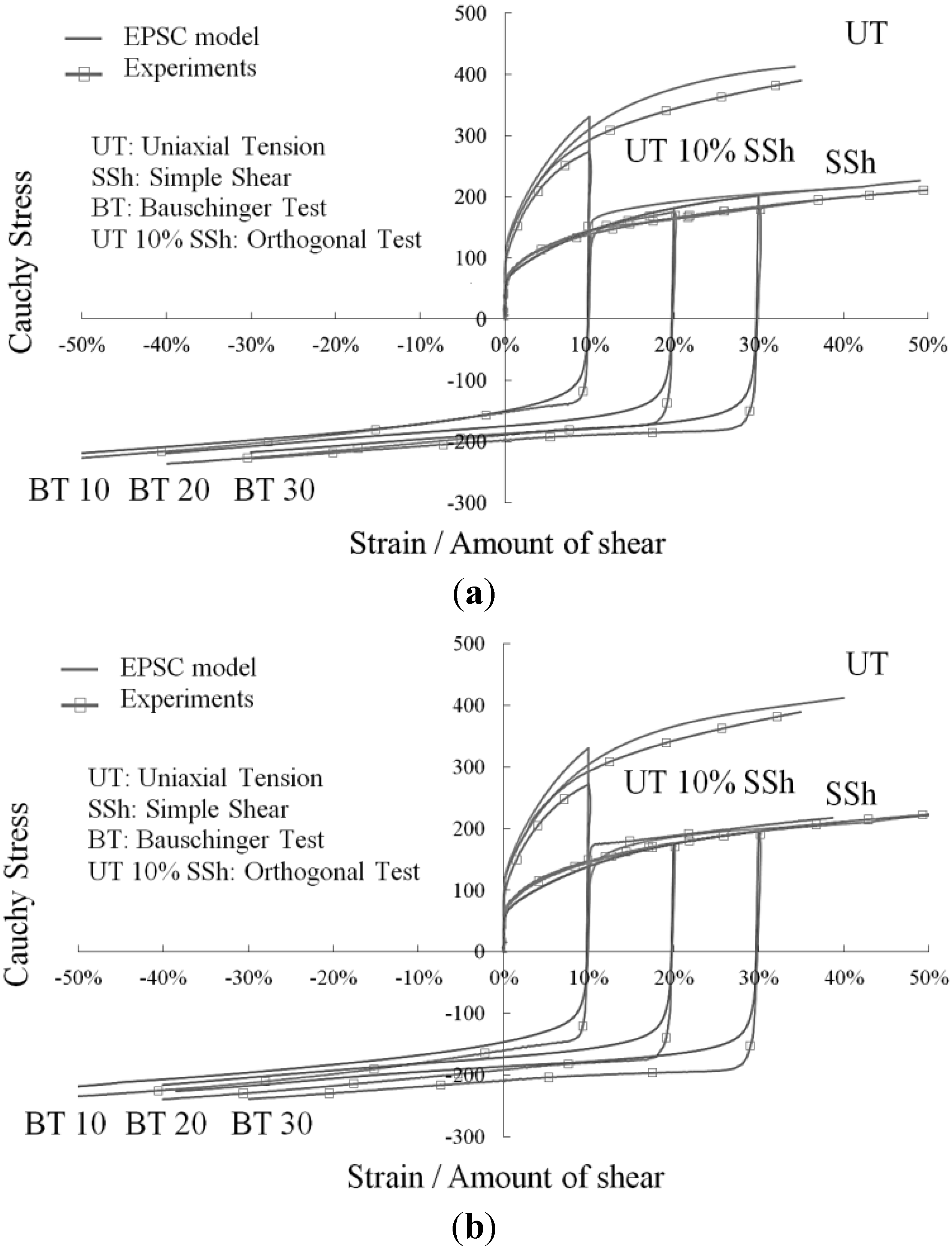
| I | R (m) | Iwd | Rwd (m) | Iwp | Rwp (m) |
| 1.8 × 10−2 | 2 × 10−9 | 6.6 × 10−2 | 1.9 × 10−9 | 2.9 × 10−2 | 2 × 10−8 |
| Rncg (m) | Rrev (m) | R2 (m) | f | τc0(110) (MPa) | τc0(112) (MPa) |
| 1 × 10−10 | 3 × 10−8 | 5 × 10−8 | 0.2 | 45 | 45 |
3. Ductility Loss Modeling
3.1. Rice’s Localization Criterion
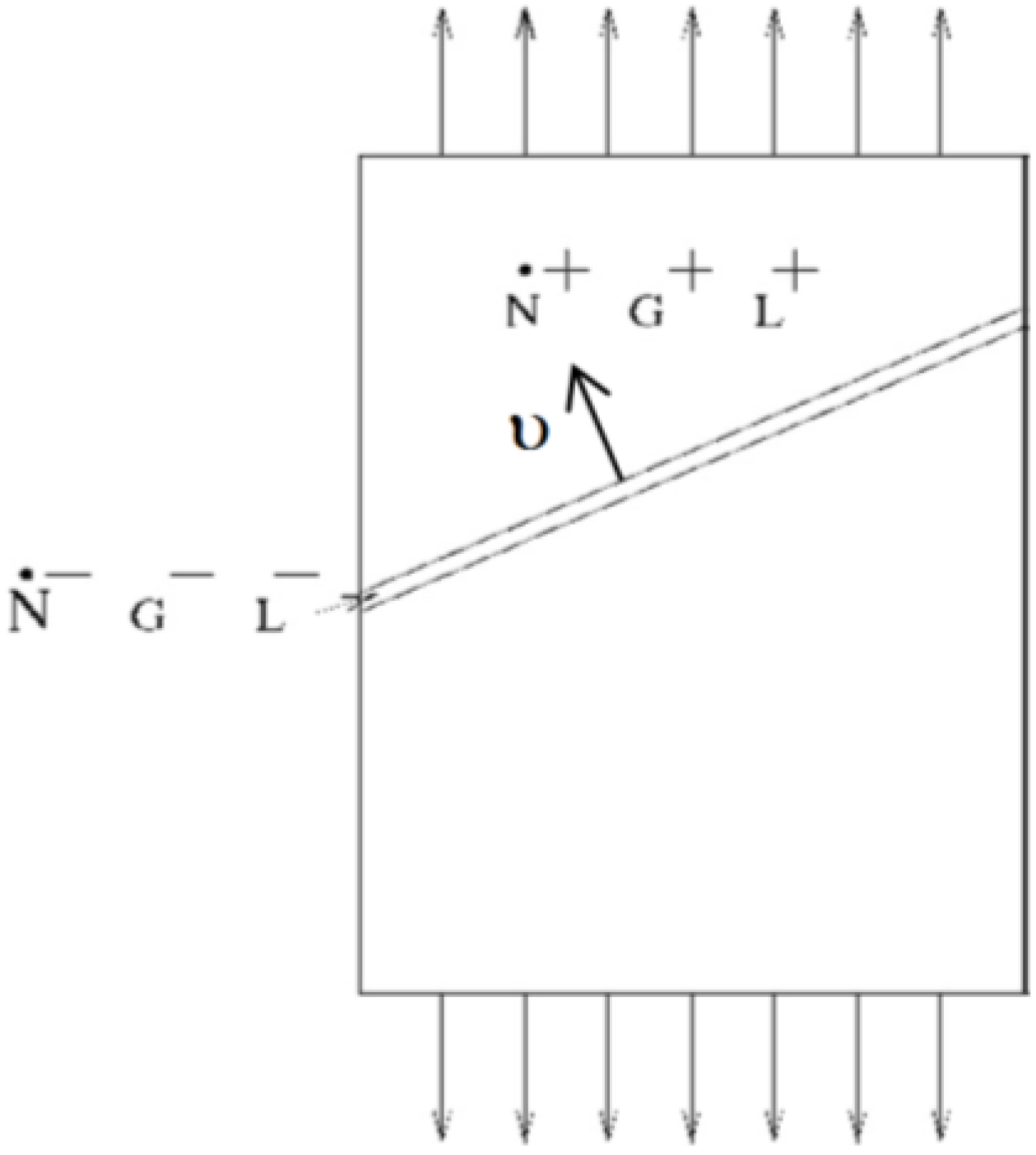
3.2. Forming Limit Diagram for Single-Phase B.C.C. Steel
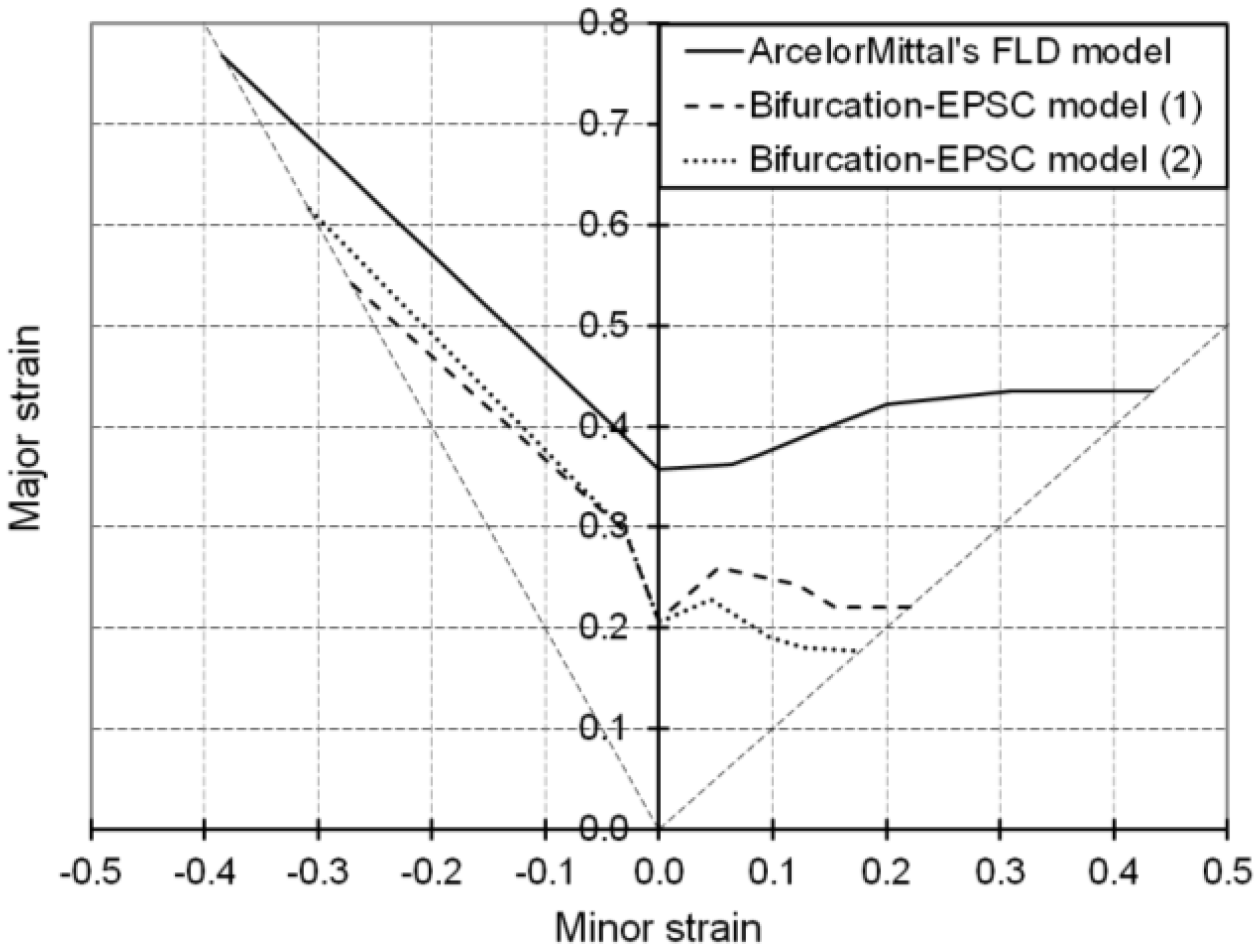
4. Impact of Substructure Features on the Forming Limit Strains of Single-Phase B.C.C. Steel
4.1. Impact of the Randomly Distributed Dislocation Network
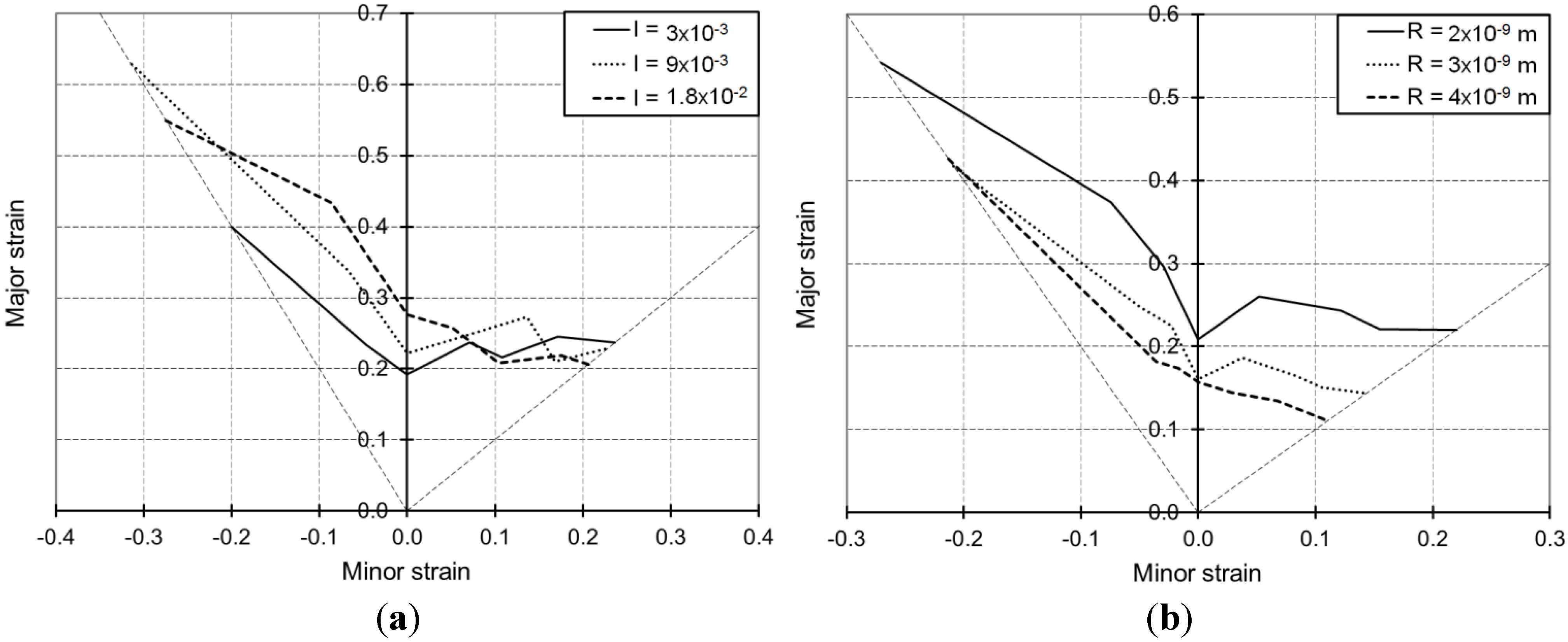
4.2. Impact of the Intensity of Dense Dislocation Sheets
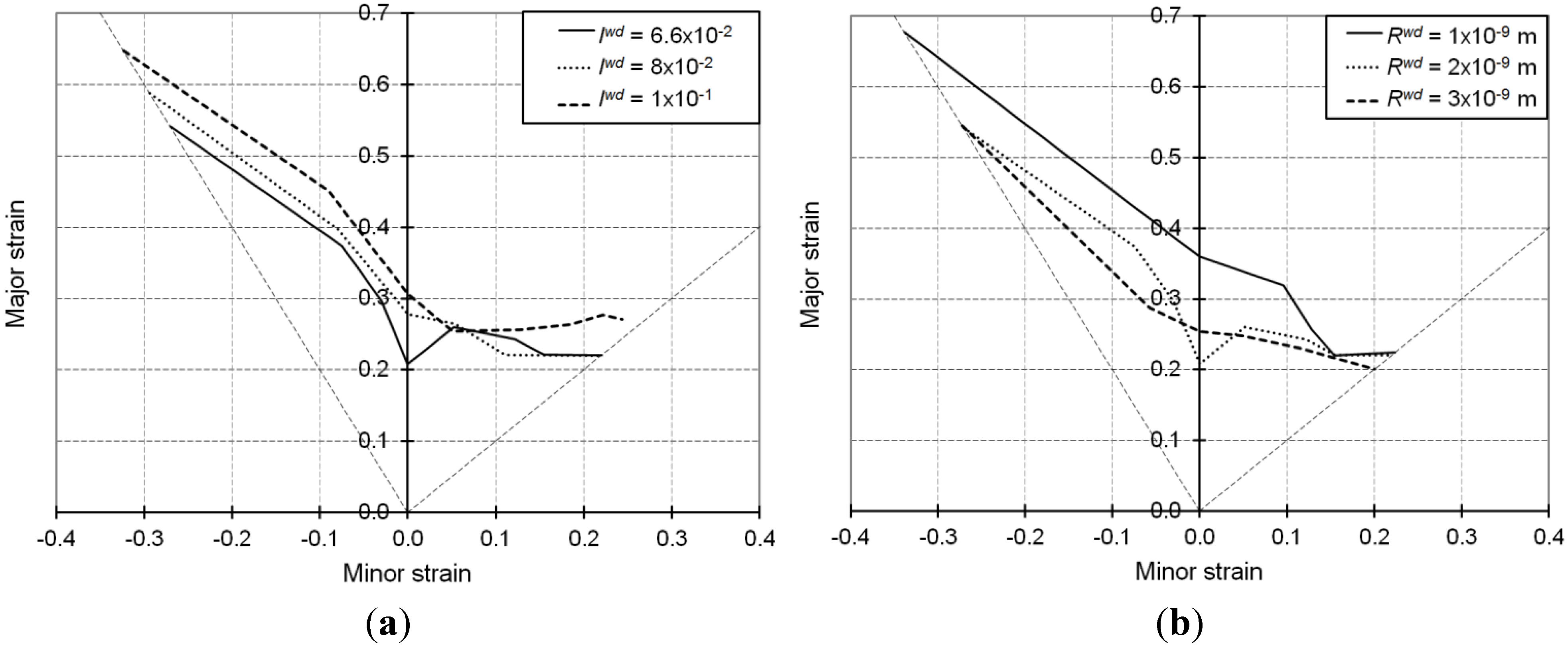
4.3. Impact of the Volume Fraction of Dense Dislocation Sheets
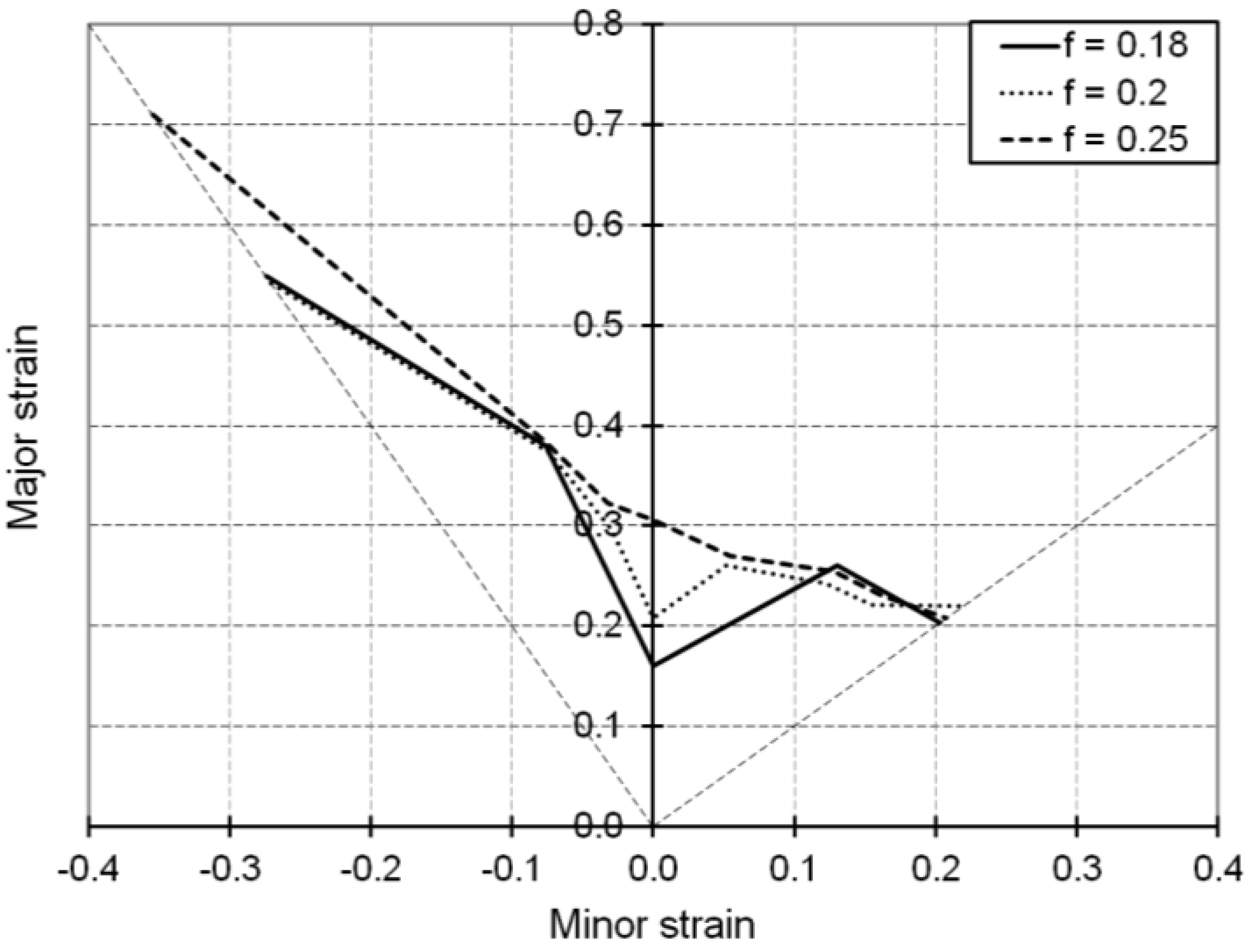
4.4. Impact of the Initial Critical Resolved Shear Stress
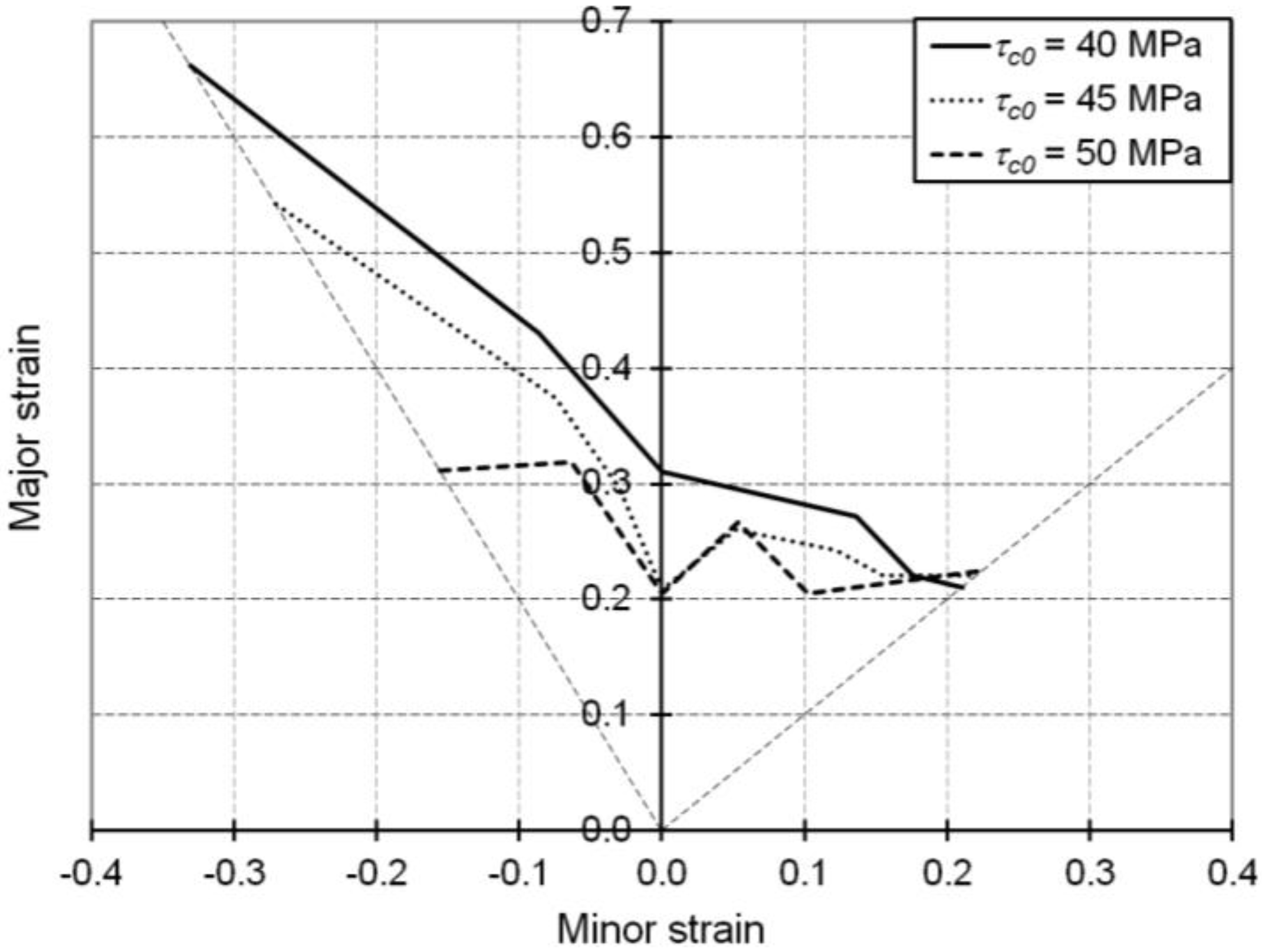
5. Conclusions
Acknowledgments
Conflicts of Interest
References
- Horstemeyer, M.F. A numerical parametric investigation of localization and forming limits. Int. J. Damage Mech. 2000, 9, 255–285. [Google Scholar] [CrossRef]
- Banabic, D.; Dannenmann, E. Prediction of the influence of yield locus on the limit strains in sheet metals. J. Mater. Proc. Technol. 2001, 109, 9–12. [Google Scholar] [CrossRef]
- Banabic, D.; Barlat, F.; Cazacu, O.; Kuwabara, T. Advances in anisotropy and formability. Int. J. Mater. Form. 2010, 3, 165–189. [Google Scholar] [CrossRef]
- Zhou, Y.; Neale, K.W. Predictions of forming limit diagrams using a rate-sensitive crystal plasticity model. Int. J. Mech. Sci. 1995, 37, 1–20. [Google Scholar] [CrossRef]
- Boudeau, N.; Gelin, J.C.; Salhi, S. Computational prediction of the localized necking in sheet forming based on microstructural material aspects. Comput. Mater. Sci. 1998, 11, 45–64. [Google Scholar] [CrossRef]
- Knockaert, R.; Chastel, Y.; Massoni, E. Forming limits prediction using rate-independent polycrystalline plasticity. Int. J. Plast. 2002, 18, 231–247. [Google Scholar] [CrossRef]
- Inal, K.; Neale, K.W.; Aboutajeddine, A. Forming limit comparisons for FCC and BCC sheets. Int. J. Plast. 2005, 21, 1255–1266. [Google Scholar] [CrossRef]
- Wu, P.D.; Graf, A.; MacEwen, S.R.; Lloyd, D.J.; Jain, M.; Neale, K.W. On forming limit stress diagram analysis. Int. J. Solids Struct. 2005, 42, 2225–2241. [Google Scholar] [CrossRef]
- Yoshida, K.; Ishizaka, T.; Kuroda, M.; Ikawa, S. The effects of texture on formability of aluminum alloy sheets. Acta Mater. 2007, 55, 4499–4506. [Google Scholar] [CrossRef]
- Signorelli, J.W.; Bertinetti, M.A.; Turner, P.A. Predictions of forming limit diagrams using a rate-dependent polycrystal self-consistent plasticity model. Int. J. Plast. 2009, 25, 1–25. [Google Scholar] [CrossRef]
- Peeters, B.; Seefeldt, M.; Teodosiu, C.; Kalidindi, S.R.; van Houtte, P.; Aernoudt, E. Work-hardening/softening behaviour of b.c.c. polycrystals during changing strain paths: I. An integrated model based on substructure and texture evolution, and its prediction of the stress–strain behaviour of an IF steel during two-stage strain paths. Acta Mater. 2001, 49, 1607–1619. [Google Scholar] [CrossRef]
- Peeters, B.; Bacroix, B.; Teodosiu, C.; van Houtte, P.; Aernoudt, E. Work-hardening/softening behaviour of b.c.c. polycrystals during changing strain paths: II. TEM observations of dislocation sheets in an IF steel during two-stage strain paths and their representation in terms of dislocation densities. Acta Mater. 2001, 49, 1621–1632. [Google Scholar] [CrossRef]
- Franz, G.; Abed-Meraim, F.; Ben Zineb, T.; Lemoine, X.; Berveiller, M. Role of intragranular microstructure development in the macroscopic behavior of multiphase steels in the context of changing strain paths. Mater. Sci. Eng. A 2009, 517, 300–311. [Google Scholar] [Green Version]
- Franz, G.; Abed-Meraim, F.; Lorrain, J.P.; Ben Zineb, T.; Lemoine, X.; Berveiller, M. Ellipticity loss analysis for tangent moduli deduced from a large strain elastic–plastic self-consistent model. Int. J. Plast. 2009, 25, 205–238. [Google Scholar] [CrossRef]
- Franz, G.; Abed-Meraim, F.; Ben Zineb, T.; Lemoine, X.; Berveiller, M. Impact of intragranular microstructure development on ductility limits of multiphase steels. Mater. Sci. Eng. A 2011, 528, 3777–3785. [Google Scholar] [CrossRef] [Green Version]
- Keh, A.S.; Weissmann, S. Deformation in Body-Centered Cubic Metals. In Electron Microscopy and Strength of Crystal; Thomas, G., Washburn, J., Eds.; Interscience: New York, NY, USA, 1963; pp. 231–300. [Google Scholar]
- Ronde-Oustau, F.; Baudelet, B. Microstructure and strain path in deep drawing. Acta Metall. 1977, 25, 1523–1529. [Google Scholar] [CrossRef]
- Fernandez, J.V.; Schmitt, J.H. Dislocation microstructures in steel during deep drawing. Philos. Mag. A 1983, 48, 841–870. [Google Scholar] [CrossRef]
- Nesterova, E.V.; Bacroix, B.; Teodosiu, C. Microstructure and texture evolution under strain-path changes in low-carbon IF steel. Metall. Mater. Trans. A 2001, 32, 2527–2538. [Google Scholar] [CrossRef]
- Rauch, E.F.; Schmitt, J.H. Dislocation substructures in mild steel deformed in simple shear. Mater. Sci. Eng. A 1989, 113, 441–448. [Google Scholar] [CrossRef]
- Mughrabi, H. Continuum Models of Discrete Systems 4. In Proceedings of the Fourth International Conference on Continuum Models of Discrete Systems, Stockholm, Sweden, 29 June–3 July 1981; pp. 241–257.
- Hill, R. Continuum micro-mechanics of elastoplastic polycrystals. J. Mech. Phys. Solids 1965, 13, 89–101. [Google Scholar] [CrossRef]
- Rudnicki, J.W.; Rice, J.R. Condition for the localization of deformation in pressure-sensitive dilatant materials. J. Mech. Phys. Solids 1975, 23, 371–394. [Google Scholar] [CrossRef]
- Rice, J.R. The Localization of Plastic Deformation. In Proceedings of the 14th International Congress of Theoretical and Applied Mechanics, Amsterdam, The Netherlands, 30 August–4 September 1976; pp. 207–220.
- Marciniak, Z.; Kuczynski, K. Limit strains in the process of stretch forming sheet metal. Int. J. Mech. Sci. 1967, 9, 609–620. [Google Scholar] [CrossRef]
- Cayssials, F. A New Method for Predicting FLC. In Proceedings of the 20th IDDRG Conference, Brussels, Belgium, 17–19 June 1998.
- Aubert, I.; Berveiller, M. Constrained and unstable expansion of dislocation loops using an invariant formulation of the free energy. Mech. Mater. 1997, 26, 127–137. [Google Scholar] [CrossRef]
- Zehetbauer, M.; Les, P.; Stüwe, H.P.; Fang, X.F. Model calculations of large strain strengthening characteristics of commercially pure b.c.c. iron. Phys. Status Solidi 1995, 151, 305–311. [Google Scholar] [CrossRef]
- Li, J.C.M.; Chou, Y.T. The role of dislocations in the flow stress grain size relationships. Metall. Mater. Trans. 1970, 1, 1145–1159. [Google Scholar]
- Luft, A. Microstructural processes of plastic instabilities in strengthened metals. Prog. Mater. Sci. 1991, 35, 97–204. [Google Scholar] [CrossRef]
© 2013 by the authors; licensee MDPI, Basel, Switzerland. This article is an open access article distributed under the terms and conditions of the Creative Commons Attribution license (http://creativecommons.org/licenses/by/3.0/).
Share and Cite
Franz, G.; Abed-Meraim, F.; Berveiller, M. Impact of Intragranular Substructure Parameters on the Forming Limit Diagrams of Single-Phase B.C.C. Steels. Materials 2013, 6, 5217-5233. https://doi.org/10.3390/ma6115217
Franz G, Abed-Meraim F, Berveiller M. Impact of Intragranular Substructure Parameters on the Forming Limit Diagrams of Single-Phase B.C.C. Steels. Materials. 2013; 6(11):5217-5233. https://doi.org/10.3390/ma6115217
Chicago/Turabian StyleFranz, Gérald, Farid Abed-Meraim, and Marcel Berveiller. 2013. "Impact of Intragranular Substructure Parameters on the Forming Limit Diagrams of Single-Phase B.C.C. Steels" Materials 6, no. 11: 5217-5233. https://doi.org/10.3390/ma6115217





